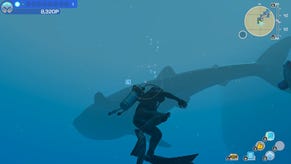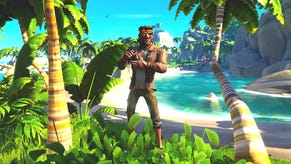Far Cry retrospective
We liked them apples.
I met up with a long-lost friend recently. "I'm gonna tear you a new one!" he shouted, almost as soon as he'd seen me in my little orange dinghy. "Suck on this!" he added.
Thankfully, I didn't suck on anything. I merely accelerated towards the beach of the first island in Far Cry's much-beloved 'Boat' level, zoomed up onto the shore, knocked him off his feet and murdered him and all his friends with a shotgun. "How'd ya like them apples?" I asked his prostrate body. Not much, I'd wager.
Oh, but how I love Far Cry. Yes, its difficulty curve becomes parabolic halfway through, but there's a feeling of freedom on its islands, mountains and winding rivers that is still remarkably fresh. On the three chunks of paradise that lie beyond my doomed friend's patrol spot, for instance, there are multiple assault points, boats to commandeer, jeeps to ram into the unwary and gliders to plummet from - albeit laced with as many save points as a failed triad has fingers. Far Cry has many imperfections - the boss battle at this level's close is a genuine horror show - but its essential beauty is never eclipsed.
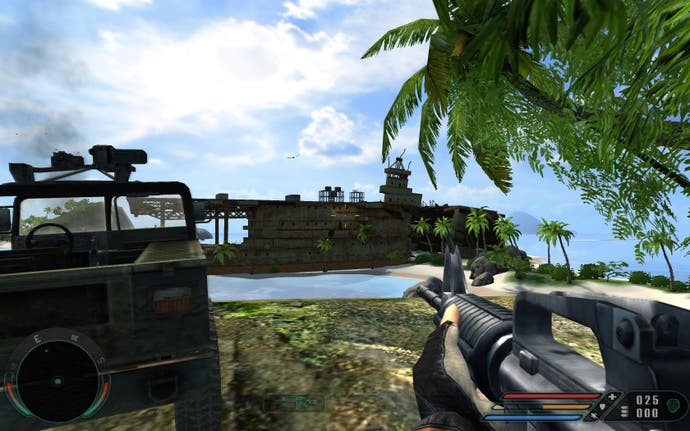
Crytek's first foray into paradise saw meathead idiot Jack Carver escorting a journalist-cum-CIA-agent called Val around the honeymoon destination of Micronesia. Here, amidst many disturbed parrots and the occasional pig, he found swarms of mercenaries to pick off from afar - a villainous crew led by a chap called Krieger who had monkey mutation mischief in mind. Alarms were slammed, alert flares went up, helicopters were called in and chimpanzee monsters were unceremoniously released from their cages - throughout the lengthy play-time, the violence felt stirringly organic. In fact, the only thing staid and one-dimensional about Far Cry was its pantomime iron-jaw hero.
Carver's loud hawaiian shirt was the closest he ever got to having a personality (and perhaps the primary reason he was so easily spotted by his foes) but thankfully his failings were drowned out by the vibrancy of the world around him. The enduring beauty of the island chain's lush maps was matched only by the clever ways Crytek would siphon you through them. Far Cry put you front and centre in free-form combat bubbles; it was an action hero simulator that encouraged you to make and break tactics on the fly. Strong tangs of the real Hollywood then doubled this down: an assault on a jungle base was lifted from Predator, while tree-top paths above rampaging Trigens were strongly redolent of Jurassic Park and its escaped raptors.
Many disliked the Trigen menace, and it's true that muto-monkeys who can kill with two swipes are hard to love. What they did provide, however, was a brigand of antagonists whose AI bled into the behaviours of Krieger's mercenaries exceptionally well. Far Cry's feeling of chaos, of being the odd one out in an unpredictable battle, was superb.
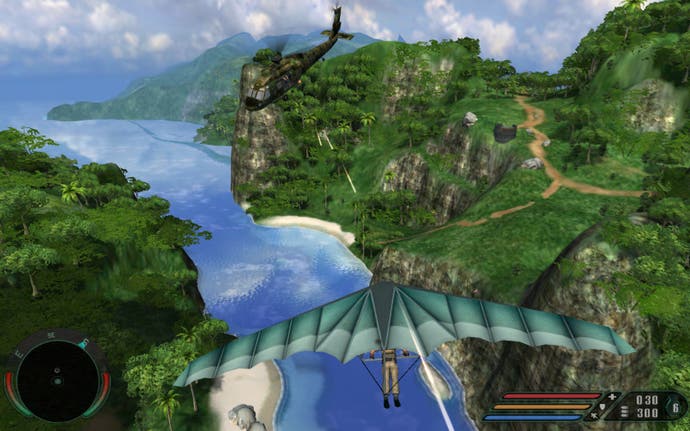
One sequence saw you surface after a long spell of corridor battling only to be faced with a blood-trimmed dawn where the Trigen rebellion had become all-out war. Leaping Trigens scaled fortress walls, desperate mercenaries sprayed bullets in all directions and lumbering beasts with rockets for hands exchanged missiles with the locals. Your only real option in this madness was to scarper. Very often, Far Cry was more about running away than getting up close and personal.
It wasn't all smiles. In fact, the Far Cry experience still runs the gamut of emotions from pure joy to a broken keyboard and bloodied handprints above your PC. A creaking auto-save system was compounded by ultra-hard enemies who could hit a bullseye from a beach hut in Brazil.
The last levels of Far Cry were easily the hardest I've ever fought through: the penultimate corridor of heavily armoured shield-bearing soldiers took countless attempts, each time demanding ever-refined tactics and an opening foray of perfectly placed grenades. And the volcano basin after that? Hours of rocket-fuelled misery followed by the most desultory of endings. "We didn't think anyone would get that far into the game," a Far Cry developer once admitted to me, mere minutes before the paramedics arrived.
So yes, late-game Far Cry remains an unbalanced nightmare. On top of this: indoor levels weren't great, keeping your play stealthy was near impossible and invisibnle Trigens can still do one - now and forever. When all this is put alongside the pleasures of blowing helicopters out of the sky as you rampage down a river in a stolen boat, or listening to distant mercenaries chatter as you tag them with your binoculars, frustation dissolves.
"A mercenary sits on one end of a see-saw (in my imagination, eating his sandwiches) while a heavy boulder precariously balances on the small cliff behind him. Gravity is a great comedian."
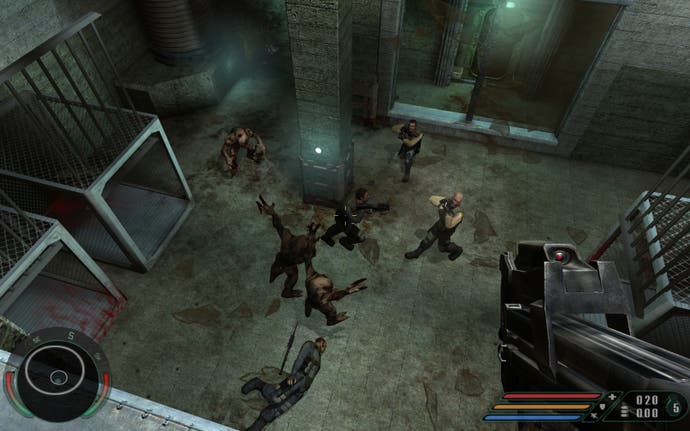
Played today, Far Cry's eccentricities still make it endearing, and not only in the way that mercenaries with rocket launchers will happily blow themselves out of their own guard towers if you approach from the right angle. Most games of its generation were addicted to physics, but Far Cry's silly, knockabout approach still shines. Every map has a strong tang of the Swiss Family Robinson - or the traps of the Ewoks, if you're that way inclined.
Heavy barrels are stored on tilted surfaces above mercenary checkpoints, while early on, a vast concrete cylinder sits at the crest of a hillock above two chattering enemies, held in place only by a sliver of plywood. Best of all, in my beloved Boat level, a mercenary sits on one end of a see-saw (in my imagination, eating his sandwiches) while a heavy boulder precariously balances on the small cliff behind him. Gravity is a great comedian.
Above all, however, a true sense of location made Far Cry special. Day turned to night, then back into day as you made your way through its levels. Locations looked real, felt real and were full of mercenaries, Trigens and terrified piggy wildlife who'd probably still be going about their business even if you weren't around to watch them. Like no other game, Far Cry made you feel like a righteous interloper and exotic holiday action hero: James Bond in Dr No, Bruce Lee in Enter the Dragon or Val Kilmer in a less terrible version of The Island of Dr Moreau.
I enjoy the Crysis games - certainly the bits in them where you kill humans - but there's no doubt in my mind that Crytek has never managed to top Far Cry and are doomed to chase their own (ever more amazingly replicated) tail forever. Far Cry 3, however, has more than delivered; it's finally a sequel that's worthy of the name. But let's never forget the blood-stained white sands that first made it possible.
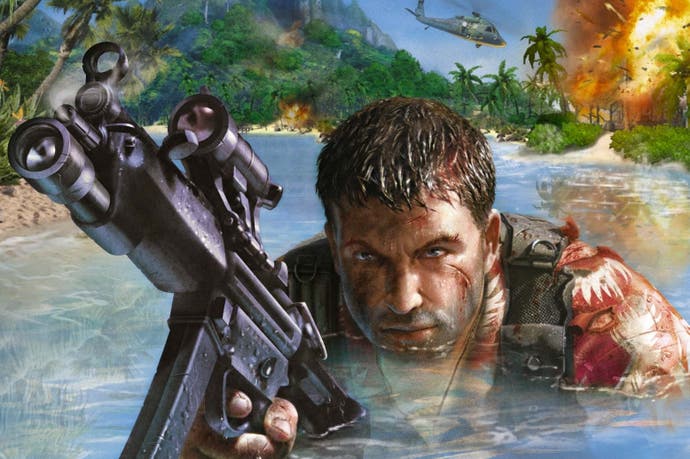




.jpg?width=291&height=164&fit=crop&quality=80&format=jpg&auto=webp)

_Rwmp6uD.jpg?width=291&height=164&fit=crop&quality=80&format=jpg&auto=webp)
